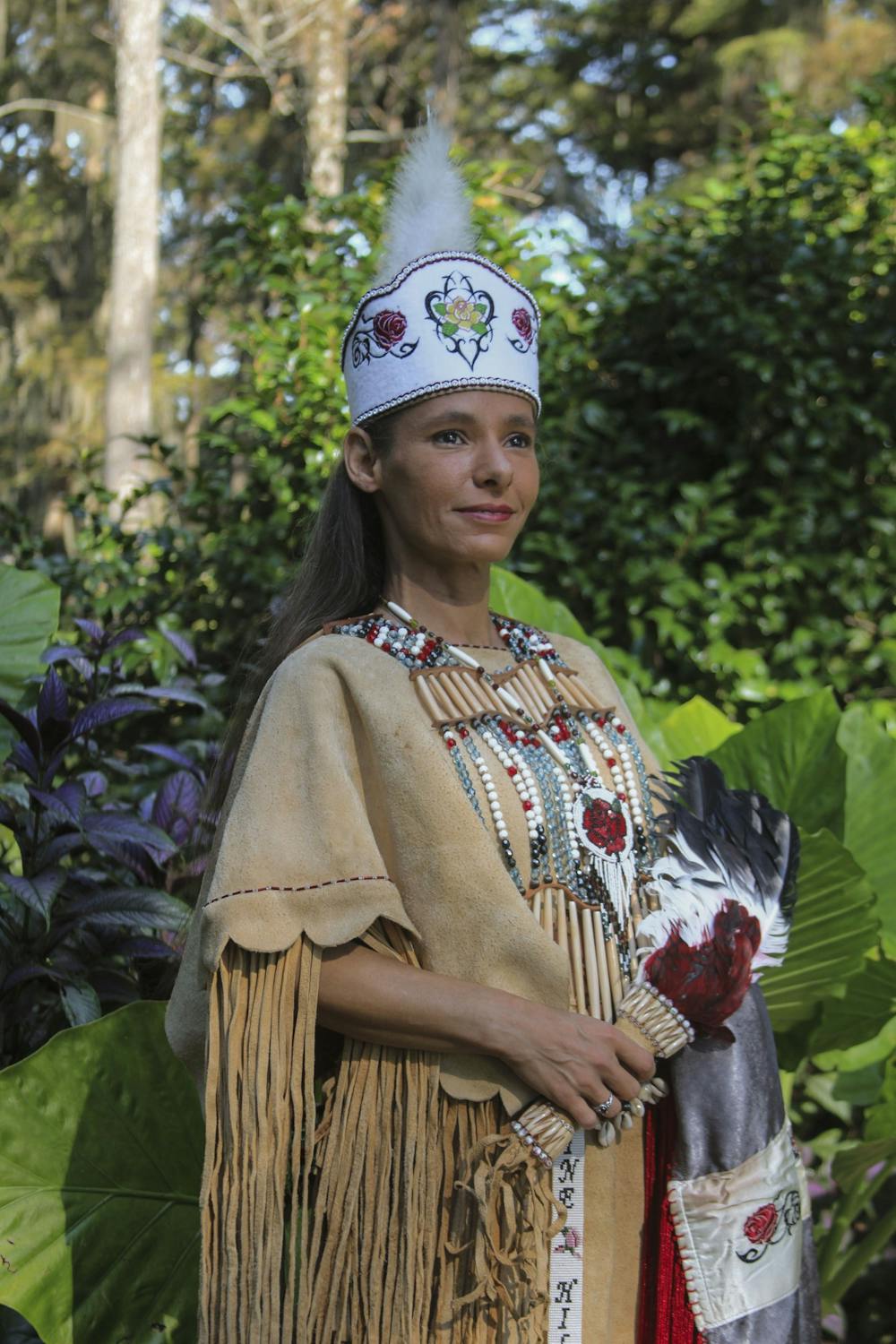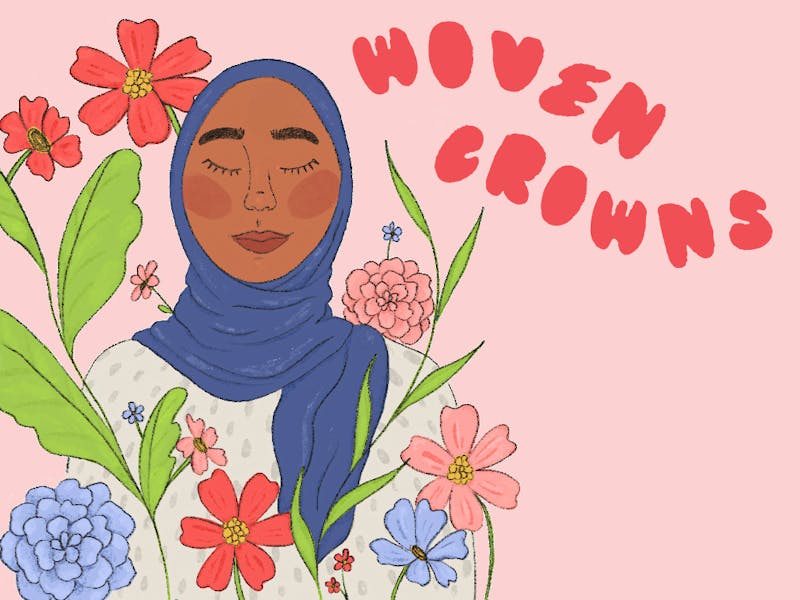Blurb and Styling by Chelsea Watson
Throughout the shoot, we wanted to highlight Native American traditional wear to honor Native roots while visually representing their culture in modern, professional attire. The idea was to illustrate the transition of Native culture meeting society. The purpose of this shoot was to show that Native Americans can still honor their heritage while working in a commercial society, as well as provide a visual representation of Native Americans in education and the workforce to show the younger indigenous generations that they can do it too.
Outfit details:
Models Name: Michelle Mitchum
Look one: Regalia: Traditional Native American Ceremonial wear
Regalia: Handmade by Michelle Mitchum
Shawl: Handmade by Michelle Mitchum
Shoes: Moccasins- Handmade by Michelle Mitchum
Accessories: Beaded Rose Necklace- Handmade by Michelle Mitchum, the fan was a gift but Michelle beaded the handle
Look two: Native Pride
Bottoms: Ribbon Skirt- Handmade by Michelle Mitchum
Top: Cream Sleeveless Top, Qearal (Model owned, price unknown)
Shoes: Brown Knee Boots- JCPenny (Model owned, price unknown)
Look three: Academia Wear
Bottoms: 9 to 5 mini skirt, Corbeau $40
Top: 9 to 5 blazer, Corbeau $48, Black Button up,
Accessories: Beaded Rose Necklace- Handmade by Michelle Mitchum
Shoes: Brown Knee Boots- JCPenny (Model owned, price unknown)
Look four: Native Causal Dresswear
Dress: Tribal Print Dress- Le Fash (Model owned, price unknown)
Shoes: Brown Knee Boots- JCPenny (Model owned, price unknown)
Native Americans are not hidden away on reservations in the west. They’re interlaced into our demographics and an integral part of our history and culture as a country. You may be surprised to learn that although the Catawba is the only federally recognized tribe in South Carolina, there are nine state-recognized tribes and at least six state-recognized groups or organizations too.
One of these groups is the Pine Hill Indian tribe of rural Western Orangeburg County. Michelle Mitchum is the Chief of this matriarchic-structured tribe. Chief Mitchum is a 47-year-old retired paralegal who worked for the Native American Bar Association and eventually dove into community health work. Her story is unique, but it highlights some of the common major problems with the treatment and visibility of Native groups in the US.
Chief Mitchum’s daughter was born when she was only a senior in high school. From an early age, Mitchum recognized the importance of education for people like her to explore life beyond the tribe. However, her tribe had different plans for her. She was forced to turn down a college scholarship as she had grown into the position of Chief of her Tribe. Chief Mitchum saw this as a “boundary,” not as a “limit.” “Our people do not see limits, but we recognize boundaries. Boundaries move,” Chief Mitchum said. She was not going to let her tribe and societal limitations control her.
By the time she decided that she would pay for college herself, she had her second child. She found herself cemented in the life of a Chief that she wanted no part of at the time. There’s no way out of becoming a Chief. It is a, “generational, lifetime title,” according to Chief Mitchum. She began her career as a paralegal, receiving her Associate’s Degree and eventually her Bachelor’s Degree in Paralegal Studies at what is now Purdue Global.
Education has never been an easy path for Native Americans. The boarding school program implemented by the government from the 1860s-1960s tore young Native students from their cultures and forced them to assimilate into white culture. The motto of these schools was, “Kill the Indian, save the man.”
The effects of these assimilation programs have affected young Native Americans’ access to education with the official policy ending less than a century ago. Today, 29%-36% of all Native American students drop out of school. This rate is even higher in areas with lower cultural understanding like South Carolina. In 2014, the Obama administration declared Native youths and their education to be in a “state of emergency.”
Mitchum was determined to be different and incite change. Her mother’s generation was the first in her tribe to graduate high school. “My adult life started out with a baby and being told what I could not do. The truth is, don’t tell me what I can’t do because I will go do it anyway,” Chief Mitchum said.
It’s almost a universal experience for Native children to feel stuck. “When you’re born into a generational poverty community, you almost have no chance of getting out,” Chief Mitchum said. This systemic-based generational poverty is hard to overcome. Societal oppression makes it even more difficult for kids to get out of their situations. The kids have to be really determined.
When Chief Mitchum went to college, her university was excited to have a Native American student. “Very often I felt like the token Indian,” Chief Mitchum said. She was good for demographics, but the school did not care about introducing actual native issues.
People would call her a witch and claim that she “worships dirt,” when, in reality, she and most of her tribe are members of a Christian church just like so many of us. Her history classes were in direct conflict with the experiences she dealt with in her life.
Even as a mother, Chief Mitchum noticed the mishandling of Native history and culture at the hands of school teachers. Her son’s first grade teacher did not understand why he was different from the other students, even going as far as treating his race like a mental impairment.
Heritage isn’t celebrated until November rolls around and suddenly it’s Native American Heritage Month. “It’s like Halloween for the other kids and they are the subject of the joke,” Chief Mitchum said. There is no wonder students drop out. They don’t feel understood or heard. They feel hopeless about their future and unable to afford education in the first place.
Common alternatives for Native kids that do not continue with school are either joining the military or becoming a criminal. Chief Mitchum’s own son joined the marine corp, which allowed him to see the world in ways he never would have in Orangeburg.
Chief Mitchum points out the issue of recidivism in her community. She defines recidivism as, “Once you go to jail, you’re perpetually going to be in jail.” When she worked as a paralegal, she supported a Native American kid who was arrested for shoplifting because he needed food. Growing up in poverty, his criminal career was already set up for him. Another time, she struggled to help a Native inmate since he had only a third grade education. He couldn’t read or write so the plea agreements were impossible for him to understand.
Overtime, the government has implemented laws to protect Native children and communities. For example, The Indian Child Welfare Act of 1978 was meant to govern the removal of Native American children. However, it only protects federally recognized Native American children. This leaves out children like Chief Mitchum, who ended up in foster care several times as a child.
“Sometimes the laws just weren’t enough,” Chief Mitchum said. Sure, laws can be designed to protect us, but it’s all in the hands of the powerful people who manipulate them. That’s one of her favorite parts of her career as a paralegal. She could protect people from those who try to exploit the law.
Chief Mitchum believes a community should not be limited because its resources are limited. This applies to the healthcare system too. Medical assistance is not readily available for rural native communities.
“Where there wasn’t, we created,” Chief Mitchum said. She retired from her work as a paralegal after 20 years to focus on community health after having her own health emergency. Thus, Pine Hill Health Network was born. The Pine Hill Health Network provides, “health and nutrition classes, diabetes classes, domestic and family violence assistance and awareness, behavioral health advocacy, and preventative substance use/misuse and sexual health education,” according to their website.
Indian Health Service found that Native Americans today have a life expectancy that is almost six years less than the U.S. all-races population. Even immunizations are not readily available to these rural communities. There are many rural communities in S.C. where mothers don’t have nearby access to an OB/GYN. Through Pine Hill Health Network’s health education, Chief Mitchum is able to combat health issues associated with isolation and poverty.
The most fundamental piece in improving the lives of Native Americans, according to Chief Mitchum, is education. First, people need to see and hear Native Americans in their own communities. Chief Mitchum points out that people don’t pay attention to who is around them. “If you see me at Walmart, would you think I was Native or would you think I was Hispanic?” asks Chief Mitchum. Native Americans are all around us and they are not all easily recognizable.
Historical information about Native Americans is not readily available. This is mainly due to the Negro Act of 1740 passed in SC, which made it illegal for enslaved African Americans to move abroad, assemble in groups, raise food, earn money and learn to read and write. The history of Native Americans is intertwined with that of African Americans. Natives were classified as mulatto, or people of mixed African and European ancestry, in S.C. for hundreds of years. They had to be self-identifying and were not allowed in the census.
This makes it even harder for educational institutions to have access to knowledge about Native Americans, especially when they refuse to listen to the Native voices who do speak out against false information. Chief Mitchum is on a committee dedicated to removing the Christopher Columbus Statue in Columbia. “Where he landed his feet was a complete massacre,” Chief Mitchum said. Still, textbooks call Columbus a hero of civilization.
“The history not being told correctly is kind of the core of the problem,” Chief Mitchum said. The federal government can implement laws to increase access to education, but it all comes down to how that one individual teacher decides to present American history.
Teachers choose to focus on viewing Native Americans through a historical lens that makes people “Native American by birth,” but a “mythical unicorn” by the standards of society, Chief Mitchum said. The school systems need to be reformed at the most intricate levels to make sure that Native American students feel heard and that the other students grow up understanding the heart of American culture.



